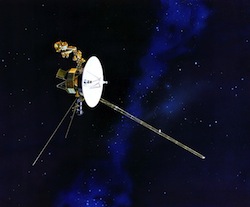Where No One Has Gone Before
 Practically everybody likes the idea of exploring space. Exploration is written right into our genetic code, from back when we wondered what was over that hill, or what lay across that sea. The “final frontier” remains an unknown and tantalizing realm of discovery and wonder. Advances made in the name of space exploration have had incalculable impacts here on earth. Dozens of products we use every day, and whole avenues of technological pursuit, trace their inception directly to the space program.
Practically everybody likes the idea of exploring space. Exploration is written right into our genetic code, from back when we wondered what was over that hill, or what lay across that sea. The “final frontier” remains an unknown and tantalizing realm of discovery and wonder. Advances made in the name of space exploration have had incalculable impacts here on earth. Dozens of products we use every day, and whole avenues of technological pursuit, trace their inception directly to the space program.
Mars rover Curiosity promises to reveal more about an alien world than all our other efforts combined. Even as Curiosity’s remarkable technology was setting the mobile laboratory down on the Red Planet, the two Voyager spacecraft were speeding toward another, almost incomprehensible milestone: thirty-five years old and change, still reporting in like clockwork, the Voyagers are about to leave what scientists consider the outermost edge of our solar system, becoming the first thing built by human hands to enter interstellar space. That will be a subtle transition, no bumpy parachuting terror like Curiosity’s descent, but in many ways it’s the more important one. All cameras on the Voyagers were long since turned off, but the craft still beam back status reports and readings. Sometime soon – it may be possible to tell when, exactly; there’s no sign and even if there is, without the cameras we couldn’t see it – sometime soon they’ll be beaming that stuff back from beyond the edge of everything we’ve ever known or been.
 If space exploration is thrilling, the challenges of exploring it are humbling. But it’s no surprise that with each success, the drive to learn more and go further strengthens. There’s still plenty to learn around here, but already some have set their sights farther. NASA and the Defense Advanced Research Projects Agency (DARPA) have announced the 100-Year Starship Initiative, a bold undertaking to get not just to the edge of the solar system, but to another star entirely. Luminaries and political figures from Star Trek cast members to former President Bill Clinton have already signed on in support of the endeavor, one which may be seen as a model for how people innovators, and even nations can solve problems in the 21st Century.
If space exploration is thrilling, the challenges of exploring it are humbling. But it’s no surprise that with each success, the drive to learn more and go further strengthens. There’s still plenty to learn around here, but already some have set their sights farther. NASA and the Defense Advanced Research Projects Agency (DARPA) have announced the 100-Year Starship Initiative, a bold undertaking to get not just to the edge of the solar system, but to another star entirely. Luminaries and political figures from Star Trek cast members to former President Bill Clinton have already signed on in support of the endeavor, one which may be seen as a model for how people innovators, and even nations can solve problems in the 21st Century.
From beginning to end, getting to another star is a huge undertaking. But identifying a far off goal and then working collaboratively to reach it, particularly with the support and blessing of practically everyone, is the model most likely to succeed. The whole thing starts modestly enough, with a public symposium from September 13-16 in Houston. The event, which will feature scientists, lecturers, politicians and other stakeholders, is intended to act as a kickoff for the century-long program – figure out what we’re trying to do, how we might get started, the things that will stand in our way and options for dealing with those obstacles.
By the time our first interstellar spacecraft actually launches, chances are everyone involved with the program at the beginning will be gone. The Voyager spacecraft, though, they’ll still be out there, by that time no longer able to power any instruments, but nonetheless speeding toward an unknown future, as all explorers boldly do.










